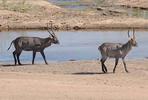
Appearance
This is a large, robust antelope. Bulls have a shoulder height of 1.4 metres and can weigh up to 260 Kg. Cows are smaller than bulls. Waterbucks have a brownish-grey shaggy coat. The eyes and nose are patched with white, and there is a white collar under the throat. The rump has a characteristic white ring. The large rounded ears are a prominent feature.
Only the bulls have long, forward curved horns. Both sexes emit a, not unpleasant, musky smell which normally lingers at resting sites.
Diet
The Waterbuck grazes mainly grass near permanent water sources. They will browse when grass cover is in a poor condition. The Waterbuck is very dependent on water and will drink daily.Breeding
Mating activities peak during winter, but it can occur at lower intensity the year round. After a gestation period of nine months, single calves are born, occasionally twins. Births tend to peak during summer. For several weeks new-born will hide-up in the cover of dense bush or long grass, before they join herds by following their mothers.
Behaviour
This is a gregarious antelope. Dominant bulls occupy territories which they defend by aggressive posturing and even fights. Cows, calves and young bachelors congregate in herds. The composition of such herds can vary daily as individuals freely leave or join these. They are strong swimmers and when seriously threatened, will take refuge in deep water. They are found in herds of up to 30 strong.Habitat
Inhabits only well watered areas, with a strong predilection for dense woody vegetation and good quality medium to tall grasses. The Waterbuck will on occasion venture into open woodlands and floodplains.Where Waterbuck Are Found
In South Africa the Waterbuck are distributed along the major drainage systems of Mpumalanga, Northern Province and northern KwaZulu-Natal. Recently re-introduced at St Lucia and Itala game reserves in KwaZulu-Natal.

Predators
Hyenas, Lions, and Leopards are the major predators, but Crocodiles, Hunting Dogs and Cheetahs also take Waterbuck.Latin name
Kobus ellipsiprymnus.Vital Statistics
- Latin Name
- Kobus Ellipsiprymnus
- Weight (Female)
- 205 - 250 kg
- Weight (Male)
- 250 - 270 kg
- Length (Female)
- 210 cm
- Length (Male)
- 210 cm
- Gestation Period
- 9 months
- No of Young
- 1 calf
- Order
- Artiodactyla
- Family
- Bovidae
- Horns
- 75 cm
- Breeding
- The calves may be born anytime of the year although calving peaks occur in the summer in some areas.
Spoor Description
The spoor of the Waterbuck depends on the age and sex. Some are broad and blunted while others may be pointed and narrow.

